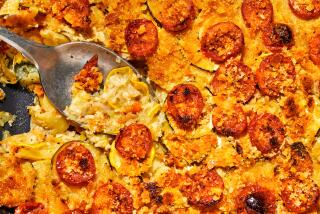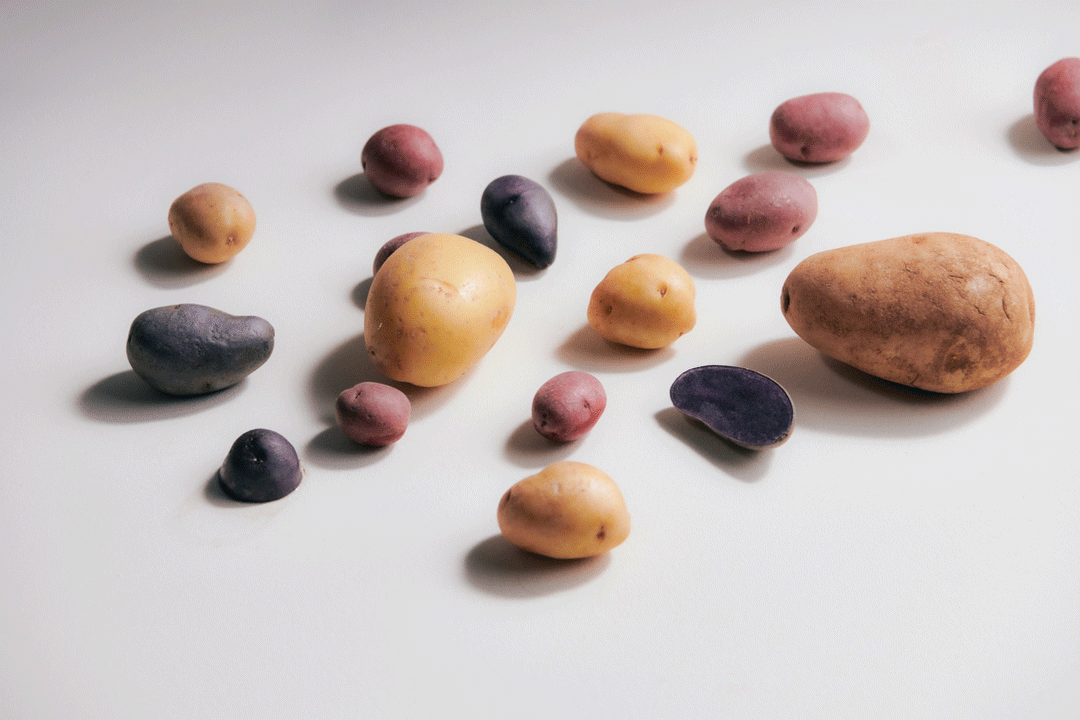Potatoes for the Purist
My friend Ed Peterson, 93-year-old head seed man at the Theodore Payne Foundationâs nursery of native plants in Sun Valley, once told me how, at the start of the Depression, he, a brother and two cousins, all born and raised in Los Angeles, drove to Nevada to find work building Hoover Dam. When none of them got hired, they spent the last of their money on gas for the trip home and a few potatoes, which they roasted over a campfire along what is now the Las Vegas Strip.
Iâve always imagined that those potatoes, with the pristine desert air as sole condiment, must have tasted wonderful, and not just because the young men were unemployed, hungry and potatoes were all they could afford. You see, I believe potatoes benefit the most from the simplest treatment. Roasting, baking, steaming or boiling is all this most neutral and satisfying of foods ever really needs.
Simplicity, though, is both their beauty and their bane. Potatoes were long considered too basic to be taken seriously. When first introduced to Europe from the New World in the late 1500s, potatoes were thought to be poisonous, fit only for animals and capable of causing leprosy. Starving peasants refused to eat what were sometimes called little truffles or edible stones, preferring wheat or death to the suspect tubers. Unfortunately, the Irish took too readily to them. By the mid-19th century, they had become a one-crop country with disastrous results.
The French were less easily impressed. One 18th century author wrote of potatoesâ ânatural insipidity,â and Brillat-Savarin described them as âeminently tasteless.â Still, shortly after the French Revolution, the Paris Commune declared the humble potato Republican and compulsory and ordered the Tuileries gardens turned into egalitarian potato fields.
Letâs face it. Potatoes are bland, which is certainly a more accurate description than buttery, even when applied to Yukon golds. And while you can find a whole slew of exotic new types at farmers markets, from purple, rose and yellow to cream, thereâs more variety in their texture than their flavor. There are no less than 3,000 different strains, with an equal number, no doubt, of ways to cook them: stuffed, mashed, smashed, scalloped, souffleed, terrined, Annaâed, Parmentiered. And underneath all the elaborate preparation and complicated saucing, the main ingredient remains essentially and indubitably, well, bland. One significant flavor factor is freshness. New potatoes, thin-skinned and recently harvested are, letâs just say, more vividly bland than potatoes that have been stored for months.
The best potatoes Iâve ever had were almost as simple as my friend Edâs, their preparation a technique more than a recipe, dictated by another friend whoâs a San Francisco food lover and gardener. He grows potatoes so that he can harvest them when they are between the size of a marble and a peanut. He boils these tiny unborn potatoes, as I call them, in heavily salted water. When theyâre tender, he drains the liquid and reheats the potatoes until the salt powders their soft skins. Then he serves them hot from the pan with a dollop of butter glistening their sides. What lies beneath their butter and salt is less a significant, describable taste than a sense of supreme comfort.
(BEGIN TEXT OF INFOBOX / INFOGRAPHIC)
SALTED UNBORN POTATOES
Serves 4 *
2 cups âunbornâ potatoes that range in size from marbles to peanuts. (You can find these at farmers markets or grow your own and dig them up at this early stage. Or use larger new potatoes about the size of an egg or fingerling potatoes.)
2 tablespoons table or coarse salt
*
Wash potatoes, cover with water in saucepan. Add salt and boil until potatoes are tender, 3 to 15 minutes, depending on their size. Drain water, return potatoes to heat and continue to cook until moisture has dried from potatoes and dusty film of salt coats their skins. Serve immediately with butter, plain or herbed.
Tarragon-Lemon-Garlic Butter
In food processor fitted with steel blade, chop 1 clove minced garlic. Add 1 teaspoon minced lemon zest, 1 to 2 tablespoons minced fresh tarragon leaves and 1 stick softened butter. Blend well. Serve on hot potatoes. Make butter a few hours in advance to allow flavors to combine. It can be refrigerated for 1 week or frozen for 3 months.
*
Food stylist: Christine Masterson
More to Read
Eat your way across L.A.
Get our weekly Tasting Notes newsletter for reviews, news and more.
You may occasionally receive promotional content from the Los Angeles Times.









